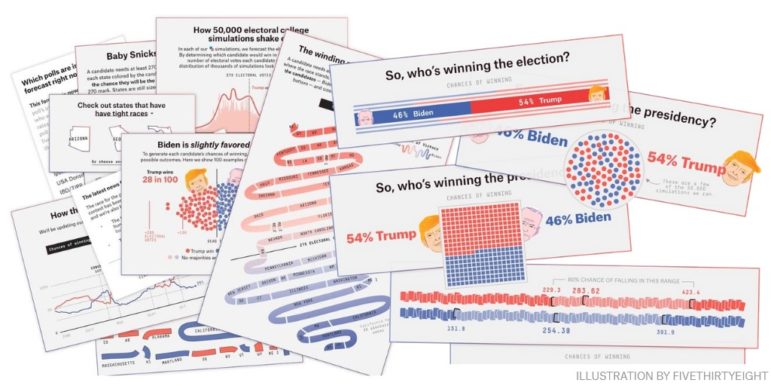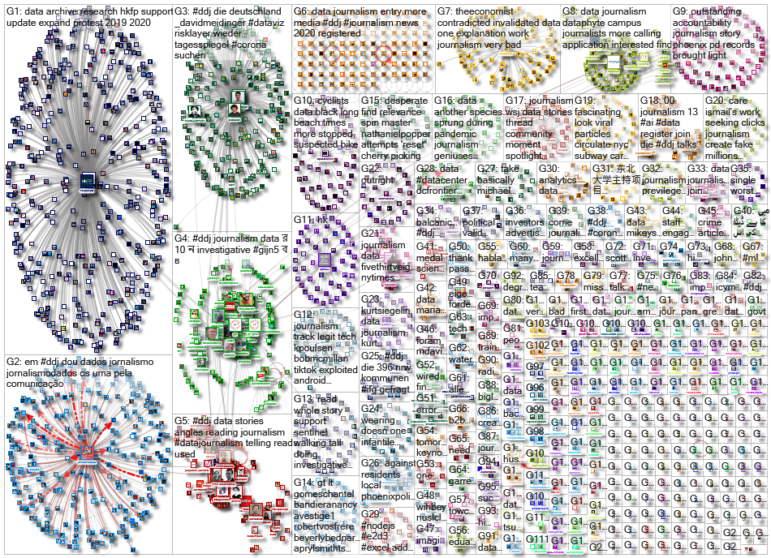

Data Journalism Top 10: Election Forecasts, The Sweatpants Era, Hong Kong Protests, DJ in Eastern Europe & Caucasus
One of the biggest issues that comes with visualizing election forecasts is how to incorporate uncertainty in a way that is understandable to readers. Our NodeXL #ddj mapping from August 10 to 16 finds FiveThirtyEight explaining its election forecast design process and considerations. Elsewhere, The New York Times Magazine has been digging into the collapse of the fashion industry, and the Hong Kong Free Press is teaming up with the Journalism and Media Studies Centre of The University of Hong Kong to expand its protest research archive.
Designing Election Forecast Models
How can journalists present an election forecast that communicates not only what is known, but also the uncertainties, and what might change in the future? Here, New York-based data and news analysis site FiveThirtyEight gives us a peek into the thought process and considerations for planning its election forecast project for the 2020 US presidential race.
The Rise of Sweatpants
The fashion industry was already unraveling before the pandemic. What happens now that no one has a reason to dress up? In April, clothing sales fell 79% in the US while purchases of sweatpants were up 80%. Although not quite a data story, The New York Times Magazine’s article about the long-anticipated collapse of the fashion industry has an interesting visual presentation. It uses a pattern-making graph paper as a background and is peppered with fashion cut-outs.
https://twitter.com/amandamull/status/1291560655229800450
Hong Kong Protest Research Archive
The Hong Kong Free Press has linked up with the University of Hong Kong’s Journalism and Media Studies Centre to provide support in updating and expanding its protest research archive. The database includes info on protest arrests, criminal charges and injuries, a timeline of demonstrations against the now-scrapped extradition bill, and a map of tear gas deployments, among other things.
https://twitter.com/tomgrundy/status/1293415133100650502
Data Scarcity Skews Research
Close to 9 in 10 academic articles published about social networks focus on Facebook, Twitter, or YouTube. Researchers say this is probably due to the reluctance of other online platforms to provide useful data, so researchers resort to the path of least resistance: studying the platforms that are more accommodating.
Germany’s Second Wave?
It seemed like the worst of the coronavirus pandemic in Germany was abating in June, but the July numbers have sparked concerns of a second wave. The national daily Der Tagesspiegel looked into the patterns and reasons why new infections are increasing again in some areas.
7 Common Data Story Angles
British data journalist Paul Bradshaw analyzed 100 pieces of data journalism and identified seven core data story angles. Using these, he wrote a piece to help journalists identify story ideas when faced with a dataset.
Data Journalism in Eastern Europe, Central Asia, and the Caucasus
Although there aren’t a large number of data journalism programs in Eastern Europe and the Caucasus, the field is attracting more and more journalists. The International Journalists Network asked several data journalism trainers from Kyrgyzstan, Belarus, Ukraine, and Georgia to share tips and resources for those looking to get started in data journalism.
Where Water Is Scarce
In Germany, climate change is heating up the soil, and water is becoming scarce as drought rages in parts of the country. The national daily Der Tagesspiegel looked into who is to blame and what measures can be taken to alleviate the problem.
Data Sunday (Portuguese)
Registrations are now open for Data Sunday, a program organized by ABRAJI, the Brazilian Association of Investigative Journalism, as part of its 15th International Congress of Investigative Journalism. The event, on 13 September, is dedicated exclusively to data journalism workshops (in Portuguese), including sessions on the programming languages R, Python, and SQL. Registration is free and the event will be held online.
https://twitter.com/Haroldob/status/1294000495720374272
Brazil Data Journalism Award
The Cláudio Weber Abramo Data Journalism Award is welcoming submissions. The award recognizes professionals and students who work with data in media investigations that affect Brazilian society. There are four categories available: data-driven research, visualization, innovation in data journalism, and open data. The winner of each category will win R$2,500.00 (US$460). Submit your work here before October 1, 2020.
Thanks again to Marc Smith of Connected Action for gathering the links and graphing them. The Top Ten #ddj list is curated weekly.
 Eunice Au is GIJN’s program coordinator. Previously, she was a Malaysia correspondent for Singapore’s The Straits Times, and a journalist at the New Straits Times. She has also written for The Sun, Malaysian Today, and Madam Chair.
Eunice Au is GIJN’s program coordinator. Previously, she was a Malaysia correspondent for Singapore’s The Straits Times, and a journalist at the New Straits Times. She has also written for The Sun, Malaysian Today, and Madam Chair.










